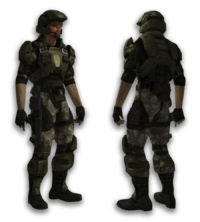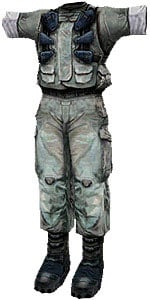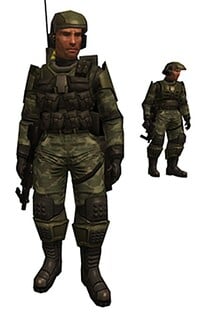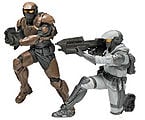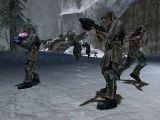UNSC Marine Corps Battle Dress Uniform
From Halopedia, the Halo wiki
The UNSC Marine Corps Battle Dress Uniform or BDU is the standard-issue combat uniform worn by the members of the UNSC Marine Corps. Inferior to more sophisticated armor suits such as the Battle Armor worn by the ODSTs or the MJOLNIR Armor worn by the SPARTANs, the armor relies on more traditional methods of protection. During operations in vacuum, Vacuum Suits such as the Black Body Suit are worn.
Introduction
As opposed to the "Dress Blues" uniforms worn at parades and functions, the BDU is intended for use in combat situations. As a large fighting force, the UNSC Marines use a great variety of different BDUs. Standard Marine Battle Dress Uniform consists of armor plating over camouflaged combat utilities, and includes a number of ammunition pockets, holsters, and other features.
Unlike the radically more advanced MJOLNIR Armor worn by the Spartan-II soldiers, the Marine BDU does not include a dynamic recharging energy shield, providing far inferior protection against directed-energy and projectile weapons.
Components
The components of the Marine BDU vary, depending on the version.
Fatigues
- Main article: Fatigues (Uniform)
Camouflaged combat utilities are worn under the armor. The UNSC is known to use a variety of camouflage patterns depending on the environments, including all-grey fatigues, woodland camouflage, urban camo or winter camouflage.
Combat boots
Combat boots such as the VZG7 Armored Boots are worn with the uniform, usually equipped with different types of additional armor to provide greater protection to the lower leg.
Armor
The Marine BDU is equipped with ballistic armor in multiple points, such as the torso, shoulders, and the lower legs. Some versions incorporate armor in the forearms and thighs as well.
The armor is extremely resilient towards traditional ballistic weaponry. However, it is fazed easily by plasma weaponry. The armor consists of several layers, some of which include a ballistic recoil-absorbing gel layer and a heat reduction gel layer to help reduce velocity and felt shock from ballistics, shrapnel, and explosives as well as reducing the burn caused by plasma once it reaches flesh.
This heat reduction layer also reduces the chance of the plasma penetrating by counter-acting and dissipating the heat, effectively disarming the blast. While this armor protects the wearer from harm caused by weaponry it also has temperature-regulation units integrated into it to keep the wearer at optimum supportability while eliminating the need to change depending on the environment. This also reduces the enemies ability to track soldiers via thermal energy as it is mostly hidden beneath this armor.
During late 2552, the M52B Body Armor was standard-issue. Lighter body armor, such as Ballistic Assault Vests are also used in some operations.
Headgear
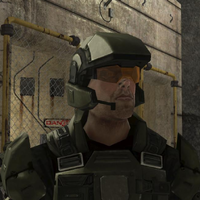
Marine helmets are mounted with high-tech equipment, such as holographic text-displaying eyepieces, helmet recorders and microphones. Tactical goggles are also used by some Marines. The CH252 Helmet and its variants are standard issue during most of 2552, and what appears to be its early version was worn already in 2531. As well as helmets, Marines on field operations in more humid locales sometimes choose to wear boonie covers, or those in colder environments don visored and thicker helmets. Marines have a Heads Up Display not just from their helmets, but from their standard Neural interface which projects HUD data directly to the Marine's retina. In hazardous situations, Gas Masks such as the S90 Gas Mask are worn.
Marine NCOs are easily recognized by the cover that they wear complete with the UNSCDF insignia, although they oftentimes substitute this soft cover for a more practical protective helmet.
Versions

There seem to be a number of varieties to the Marine BDU. It is unknown if the changes between the games are instances of different armor models altogether, or if the changes are simply aesthetic.
Halo: Combat Evolved
The equipment used during the Battle of Installation 04 involved gray fatigues, and over that, pieces of brown armor plating covering the head, torso, shoulders, thighs and shins. At times, the Marines only wore their utilities and soft body armor, even forgoing helmets and body armor plating in hazardous combat operations. At times, their helmets were also substituted for boonie covers and sometimes bandanas. Some Marines had small medical packs built into their back armor plating. The helmets also included a small, green tactical eyepiece, a feature not seen in any other versions.[1]
Halo 2
The design of the Marine BDU was completely overhauled for Halo 2. The uniform involved olive green armor pieces, with a woodland camouflage-covered battledress. It had less armor pieces than the variant seen in the first game, namely lacking armor on the thighs.[2].
Halo 3 and Halo 3: ODST
In Halo 3 and Halo 3: ODST, the BDU used by the UNSC Marine Corps was fairly similar to the one in Halo 2, with several changes. The fatigues now had an urban camouflage, while the armor itself retained its olive-green color. The armor is still labeled as M52B on containers in Halo 3.
This variant is an evolution from the Halo 2 version, with heavier and well-articulated olive-drab full body armor (armored vest, shoulder plates, elbow pads, and knee pads) over urban camouflage utilities. Marines sometimes don small helmet communications microphones or black-phased sunglasses on their helmets, and others carry backpacks. Marines have been seen to wear black gloves, probably to protect their hands and improve their grip on their weapons.[3]
Halo Wars
In 2531, the standard Marine uniform involved gray fatigues, with shiny-brown armor covering most of the body. The Marine uniform used on the cold environments of Harvest consisted of environmentally-tailored armor, with insulated snow camouflage utilities and full body armor and well as insulated and visored helmets with something analogous to a balaclava.
Trivia
- The Halo: Combat Evolved variant of the armor appears to have been inspired by the armor worn by the Colonial Marines in the film Aliens, which influenced Halo in multiple ways.
Gallery
- All.marines.jpg
An early design of the armor.
- H3 Zune Marine.jpg
Concept art of the armor for Halo 3.
Sources
